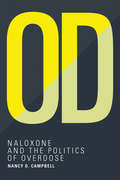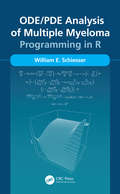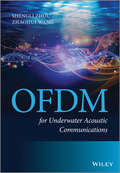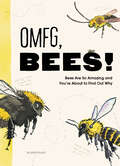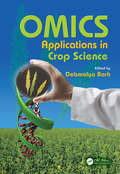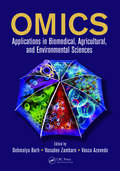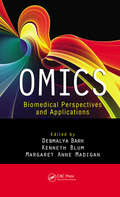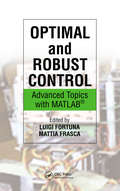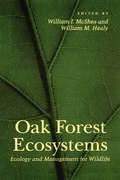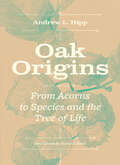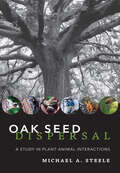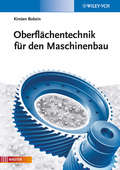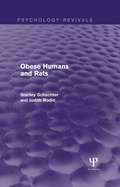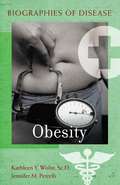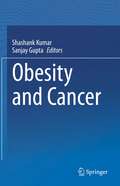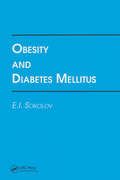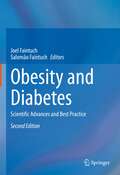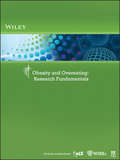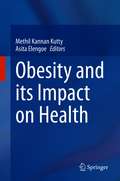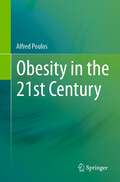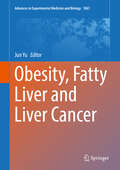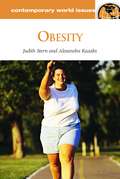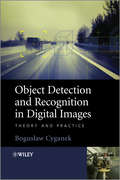- Table View
- List View
OD: Naloxone and the Politics of Overdose (Inside Technology)
by Nancy D. CampbellThe history of an unnatural disaster—drug overdose—and the emergence of naloxone as a social and technological solution.For years, drug overdose was unmentionable in polite society. OD was understood to be something that took place in dark alleys—an ugly death awaiting social deviants—neither scientifically nor clinically interesting. But over the last several years, overdose prevention has become the unlikely object of a social movement, powered by the miracle drug naloxone. In OD, Nancy Campbell charts the emergence of naloxone as a technological fix for overdose and describes the remaking of overdose into an experience recognized as common, predictable, patterned—and, above all, preventable. Naloxone, which made resuscitation, rescue, and “reversal” after an overdose possible, became a tool for shifting law, policy, clinical medicine, and science toward harm reduction. Liberated from emergency room protocols and distributed in take-home kits to non-medical professionals, it also became a tool of empowerment.After recounting the prehistory of naloxone—the early treatment of OD as a problem of poisoning, the development of nalorphine (naloxone's predecessor), the idea of “reanimatology”—Campbell describes how naloxone emerged as a tool of harm reduction. She reports on naloxone use in far-flung locations that include post-Thatcherite Britain, rural New Mexico, and cities and towns in Massachusetts. Drawing on interviews with approximately sixty advocates, drug users, former users, friends, families, witnesses, clinicians, and scientists—whom she calls the “protagonists” of her story—Campbell tells a story of saving lives amid the complex, difficult conditions of an unfolding unnatural disaster.
ODE/PDE Analysis of Multiple Myeloma: Programming in R
by William E. SchiesserMultiple myeloma is a form of bone cancer. Specifically, it is a cancer of the plasma cells found in bone marrow (bone soft tissue). Normal plasma cells are an important part of the immune system. Mathematical models for multiple myeloma based on ordinary and partial differential equations (ODE/PDEs) are presented in this book, starting with a basic ODE model in Chapter 1, and concluding with a detailed ODE/PDE model in Chapter 4 that gives the spatiotemporal distribution of four dependent variable components in the bone marrow and peripheral blood: (1) protein produced by multiple myeloma cells, termed the M protein, (2) cytotoxic T lymphocytes (CTLs), (3) natural killer (NK) cells, and (4) regulatory T cells (Tregs). The computer-based implementation of the example models is presented through routines coded (programmed) in R, a quality, open-source scientific computing system that is readily available from the Internet. Formal mathematics is minimized, e.g., no theorems and proofs. Rather, the presentation is through detailed examples that the reader/researcher/analyst can execute on modest computers using the R routines that are available through a download. The PDE analysis is based on the method of lines (MOL), an established general algorithm for PDEs, implemented with finite differences.
OFDM for Underwater Acoustic Communications
by Zhaohui Wang Sheng ZhouA blend of introductory material and advanced signal processing and communication techniques, of critical importance to underwater system and network development This book, which is the first to describe the processing techniques central to underwater OFDM, is arranged into four distinct sections: First, it describes the characteristics of underwater acoustic channels, and stresses the difference from wireless radio channels. Then it goes over the basics of OFDM and channel coding. The second part starts with an overview of the OFDM receiver, and develops various modules for the receiver design in systems with single or multiple transmitters. This is the main body of the book. Extensive experimental data sets are used to verify the receiver performance. In the third part, the authors discuss applications of the OFDM receiver in i) deep water channels, which may contain very long separated multipath clusters, ii) interference-rich environments, where an unintentional interference such as Sonar will be present, and iii) a network with multiple users where both non-cooperative and cooperative underwater communications are developed. Lastly, it describes the development of a positioning system with OFDM waveforms, and the progress on the OFDM modem development. Closely related industries include the development and manufacturing of autonomous underwater vehicles (AUVs) and scientific sensory equipment. AUVs and sensors in the future could integrate modems, based on the OFDM technology described in this book. Contents includes: Underwater acoustic channel characteristics/OFDM basics/Peak-to-average-ratio control/Detection and Doppler estimation (Doppler scale and CFO)/Channel estimation and noise estimation/A block-by-block progressive receiver and performance results/Extensions to multi-input multi-output OFDM/Receiver designs for multiple users/Cooperative underwater OFDM (Physical layer network coding and dynamic coded cooperation)/Localization with OFDM waveforms/Modem developments A valuable resource for Graduate and postgraduate students on electrical engineering or physics courses; electrical engineers, underwater acousticians, communications engineers
OMFG, BEES!: Bees Are So Amazing and You're About to Find Out Why
by Matt KrachtAre you ready for the ultimate bee book? With lighthearted watercolor and ink drawings, humorous quips, lists, and musings, OMFG, BEES! will show you just how important these esteemed bee-list celebrities really are. (Hint: We can't live without them.)Delving into various bee topics, from distinguishing between bees and not bees (very crucial), to exploring the absolute wonder that is bee behavior (they do a coded dance directing their bee friends to food, for crying out loud!), to divulging the mind-blowing bee-magic behind honey making (within some extremely intricate and precisely constructed hexagonal honeycomb, no big deal), and more, Kracht's ode to bees paints a charming and enthusiastic picture of our favorite pollinators.Bee-autiful full-color illustrations fill these pages that playfully and earnestly examine different kinds of bees, from the honeybee to the teddy bear bee, providing unbelievably cool facts about bees and reasons why they deserve a lot more credit as well as our appreciation and advocacy. Because omfg, BEES!!
OMICS Applications in Crop Science
by Debmalya BarhMerging topical data from recently published review and research articles, as well as the knowledge and insight of industry experts, Omics Applications in Crop Science delves into plant science, and various technologies that use omics in agriculture. This book concentrates on crop breeding and environmental applications, and examines the applicatio
OMICS: Applications in Biomedical, Agricultural, and Environmental Sciences
by Debmalya Barh Vasco Azevedo Vasudeo ZambareWith the advent of new technologies and acquired knowledge, the number of fields in omics and their applications in diverse areas are rapidly increasing in the postgenomics era. Such emerging fields-including pharmacogenomics, toxicogenomics, regulomics, spliceomics, metagenomics, and environomics-present budding solutions to combat global challeng
OMICS: Biomedical Perspectives and Applications
by Kenneth Blum Debmalya Barh Margaret Anne MadiganA reflection of the explosion of research and development in this field, OMICS: Biomedical Perspectives and Applications explores applications of omics in bioinformatics, cancer research and therapy, diabetes research, plant science, molecular biology, and neurosciences. A select editorial panel of experts discusses their cutting edge omics researc
OPTIMAL and ROBUST CONTROL: Advanced Topics With Matlab®
by Luigi Fortuna Mattia FrascaWhile there are many books on advanced control for specialists, there are few that present these topics for nonspecialists. Assuming only a basic knowledge of automatic control and signals and systems, Optimal and Robust Control: Advanced Topics with MATLAB® offers a straightforward, self-contained handbook of advanced topics and tools in automatic control. Techniques for Controlling System Performance in the Presence of Uncertainty The book deals with advanced automatic control techniques, paying particular attention to robustness—the ability to guarantee stability in the presence of uncertainty. It explains advanced techniques for handling uncertainty and optimizing the control loop. It also details analytical strategies for obtaining reduced order models. The authors then propose using the Linear Matrix Inequalities (LMI) technique as a unifying tool to solve many types of advanced control problems.
OZONE
by Velio BocciOxygen-Ozone therapy is a complementary approach less known than homeopathy and acupuncture because it has come of age only three decades ago. This book clarifies that, in the often nebulous field of natural medicine, the biological bases of ozone therapy are totally in line with classical biochemistry, physiological and pharmacological knowledge. Ozone is an oxidizing molecule, a sort of super active oxygen, which, by reacting with blood components generates a number of chemical messengers responsible for activating crucial biological functions such as oxygen delivery, immune activation, release of hormones and induction of antioxidant enzymes, which is an exceptional property for correcting the chronic oxidative stress present in atherosclerosis, diabetes and cancer. Moreover, by inducing nitric oxide synthase, ozone therapy may mobilize endogenous stem cells, which will promote regeneration of ischemic tissues. The description of these phenomena offers the first comprehensive picture for understanding how ozone works and why. When properly used as a real drug within therapeutic range, ozone therapy does not only does not procure adverse effects but yields a feeling of wellness. Half the book describes the value of ozone treatment in several diseases, particularly cutanious infection and vascular diseases where ozone really behaves as a "wonder drug". The book has been written for clinical researchers, physicians and ozone therapists, but also for the layman or the patient interested in this therapy.
OZONE: A new medical drug
by Velio BocciOxygen-Ozone therapy is a complementary approach less known than homeopathy and acupuncture because it has come of age only three decades ago. This book clarifies that, in the often nebulous field of natural medicine, the biological bases of ozone therapy are totally in line with classical biochemistry, physiological and pharmacological knowledge. Ozone is an oxidizing molecule, a sort of super active oxygen, which, by reacting with blood components generates a number of chemical messengers responsible for activating crucial biological functions such as oxygen delivery, immune activation, release of hormones and induction of antioxidant enzymes, which is an exceptional property for correcting the chronic oxidative stress present in atherosclerosis, diabetes and cancer. Moreover, by inducing nitric oxide synthase, ozone therapy may mobilize endogenous stem cells, which will promote regeneration of ischemic tissues. The description of these phenomena offers the first comprehensive picture for understanding how ozone works and why. When properly used as a real drug within therapeutic range, ozone therapy does not only does not procure adverse effects but yields a feeling of wellness. Half the book describes the value of ozone treatment in several diseases, particularly cutanious infection and vascular diseases where ozone really behaves as a “wonder drug”. The book has been written for clinical researchers, physicians and ozone therapists, but also for the layman or the patient interested in this therapy.
Oak Forest Ecosystems: Ecology and Management for Wildlife
by William J. McSheaOak Forest Ecosystems focuses on the relationship between an oak forest's acorn yield and species of wildlife that depend on it. It begins by treating factors such as oak distribution, forest fires, tree diseases and pests, dynamics of acorn production, and acorn dispersal by birds and mammals. Special consideration is given to the phenomenon of masting—whereby oaks in a given area will produce huge crops of acorns at irregular intervals—a key component for wildlife researchers and managers in understanding patterns of scarcity and abundance in the creatures that feed on this crop. Relationships between oaks and animals such as mice, squirrels, turkeys, deer, and bear are discussed, as are the differences between eastern, southern Appalachian, southwestern, and California oak forests. Contributors: Marc D. Abrams, Pennsylvania State University • Patrick H. Brose, U.S. Department of Agriculture Forest Service • John P. Buonaccorsi, University of Massachusetts • Daniel Dey, U.S. Department of Agriculture Forest Service • Joseph S. Elkinton, University of Massachusetts • George A. Feldhamer, Southern Illinois University • Peter F. Folliott, University of Arizona • Lee E. Frelich, University of Minnesota • Cathryn H. Greenberg, U.S. Department of Agriculture Forest Service • William M. Healy, U.S. Department of Agriculture Forest Service • Roy L. Kirkpatrick, Virginia Polytechnic Institute and State University • Johannes M. H. Knops, University of Nebraska • Walter D. Koenig, University of California • Nelson W. Lafon, Virginia Department of Game and Inland Fisheries • Andrew M. Liebhold, U.S. Department of Agriculture Forest Service • William J. McShea, National Zoological Park Conservation and Research Center • William H. McWilliams, U.S. Department of Agriculture Forest Service • Gary W. Norman, Virginia Department of Game and Inland Fisheries • Steven W. Oak, U.S. Department of Agriculture Forest Service • Renee A. O'Brien, U.S. Department of Agriculture Forest Service • Richard S. Ostfeld, Institute of Ecosystem Studies • Bernard R. Parresol, U.S. Department of Agriculture Forest Service • Peter J. Perkins, University of New Hampshire • Gordon C. Reese, Colorado State University • Peter B. Reich, University of Minnesota • Peter D. Smallwood, University of Richmond • Christopher C. Smith, Kansas State University • Richard B. Standiford, University of California–Berkeley • Martin A. Stapanian, Ohio Cooperative Wildlife Unit • Michael A. Steele, Wilkes University • David Steffen, Virginia Department of Game and Inland Fisheries • David H. Van Lear, Clemson University • Michael R. Vaughan, Virginia Polytechnic Institute and State University • Karen L. Waddell, U.S. Department of Agriculture Forest Service
Oak Origins: From Acorns to Species and the Tree of Life
by Andrew L. HippFrom ancient acorns to future forests, the story of how oaks evolved and the many ways they shape our world. An oak begins its life with the precarious journey of a pollen grain, then an acorn, then a seedling. A mature tree may shed millions of acorns, but only a handful will grow. One oak may then live 100 years, 250 years, or even 13,000 years. But the long life of an individual is only a part of these trees’ story. With naturalist and leading researcher Andrew L. Hipp as our guide, Oak Origins takes us through a sweeping evolutionary history, stretching back to a population of trees that lived more than 50 million years ago. We travel to the ancient tropical Earth to see the ancestors of the oaks evolving side by side with the dinosaurs. We journey from the oaks’ childhood in the once-warm forests of the Arctic to the montane cloud forests of Mexico and the broad-leaved evergreen forests of Southeast Asia. We dive into current research on oak genomes to see how scientists study genes’ movement between species and how oaks evolve over generations—spanning tens of millions of years. Finally, we learn how oak evolutionary history shapes the forests we know today, and how it may even shape the forests of the future. Oaks are familiar to almost everyone, and beloved. They are embedded in our mythology. They have fed us, housed us, provided wood for our ships and wine barrels and homes and halls, planked our roads, and kept us warm. Every oak also has the potential to feed thousands of birds, squirrels, and mice and host countless insects, mosses, fungi, and lichens. But as Oak Origins makes clear, the story of the oaks’ evolution is not just the story of one important tree. It is the story of the Tree of Life, connecting all organisms that have ever lived on Earth, from oaks’ last common ancestor to us.
Oak Seed Dispersal: A Study in Plant-Animal Interactions
by Michael A. SteeleThe definitive examination of oak forest evolutionary ecology.Seed dispersal is a critical stage in the life cycle of most flowering plants. The process can have far-reaching effects on a species' biology, especially numerous aspects of its ecology and evolution. This is particularly the case for the oaks, in which the dispersal of the acorn is tied to numerous tree characteristics, as well as the behavior and ecology of the animals that feed on and move these seeds to their final destination. Forest structure, composition, and genetics often follow directly from the dispersal process—while also influencing it in turn. In Oak Seed Dispersal, Michael A. Steele draws on three decades of field research across the globe (e.g., the United States, Mexico, Central America, Europe, and China) to describe the interactions between oaks and their seed consumers. Rodents, birds, and insects, he writes, collectively influence the survival, movement, and germination of acorns, as well as the establishment of seedlings, often indicating a coevolutionary bond between oaks and their seed consumers. This bond can only be understood by unraveling the complex interactions that occur in the context of factors such as partial seed consumption due to acorn chemistry, scatterhoarding, predation of the seed consumers by other organisms, and the limiting effects of masting on insect, rodent, and jay damage.Offering new insights on how animal-mediated dispersal drives ecological and evolutionary processes in forest ecosystems, Oak Seed Dispersal also includes an overview of threatened oak forests across the globe and explains how a lack of acorn dispersal contributes to many important conservation challenges. Highly illustrated, the book includes photographs of key dispersal organisms and tactics, as well as a foreword by Stephen B. Vander Wall, a leading authority on food hoarding and animal-mediated seed dispersal, and beautiful artwork by Tad C. Theimer, also an accomplished ecologist.
Oberflächentechnik für den Maschinenbau
by Kirsten BobzinTribologie, Korrosion, Konstruktion und Werkstofftechnik sind Wissensbereiche, die sich zunächst parallel entwickelt haben. Das gleiche gilt für die verschiedenen Verfahren der Oberflächentechnik. Heute wird es zunehmend wichtiger, interdisziplinäre Ansätze zu finden, um die Problemstellungen der Zukunft, wie z.B. Umweltschutz oder Ressourcenschonung, gemeinsam zu lösen. Das Buch verfolgt den Ansatz, diese Wissensbereiche zu verknüpfen. Es beginnt mit einer Beschreibung technischer Oberflächen hinsichtlich chemischer Zusammensetzung und geometrischer Struktur. Technische Systeme des Maschinenbaus (Bauteile oder Werkzeuge) sind Umgebungseinflüssen (Druck, Chemie, Temperatur) ausgesetzt, die zu Oberflächenschäden durch Verschleiß und Korrosion führen können. Um Oberflächen davor zu schützen, müssen die Grundlagen der Tribologie (Lehre von Reibung und Verschleiß) und Korrosion zunächst verstanden sein, weshalb die wichtigsten Begriffe und Definitionen zu Beginn des Buches beschrieben werden. Schwerpunkt des Buches ist die Behandlung der Verfahren der Oberflächentechnik, die im Maschinenbau Anwendung finden. Jedes Verfahren wird hinsichtlich Beschichtungsprozess, Anlagentechnik, Schichtwerkstoffen, typischen Schichtdicken, Beschichtungstemperaturen und Schichtwerkstoffen beschrieben und anhand von Anwendungsbeispielen vorgestellt. Wesentliches Element der Oberflächentechnik ist die Kombination unterschiedlicher Werkstoffe oder Werkstoffeigenschaften, um Volumen- und Oberflächeneigenschaften getrennt voneinander entsprechend der Anwendung optimieren zu können. Daher ist abschließend eine sehr kurze Einteilung wichtiger Werkstoffe gegeben (Metalle, Keramiken, Polymere). Die Kombination aus Tribologie, Korrosion, Verfahren der Oberflächentechnik und Werkstoffkunde ermöglicht eine strukturierte Herangehensweise bei der Auslegung von Oberflächen.
Obese Humans and Rats (Psychology Revivals)
by Judith Rodin Stanley SchacterOriginally published in 1974, this volume examines the behavioural similarities of obese humans and animals whose so-called feeding centre (the ventro-medial hypothalamic nuclei) has been lesioned. Both the obese human and the VMH-lesioned animal seem to share a hyposensitivity to the internal (physiological) cues to eating and hypersensitivity to external cues associated with food. Beginning with a review, these obese animals and the human obese are compared point by point on experimental results reported in the literature. Then, new findings are presented that specifically tested humans for relationships that are well-established for lesioned animals. Next, a theoretical framework integrates the human and animal data to postulate that the relationship of cue prominence and probability of response is stronger for the obese than for normal. The causes for this, and the extension of the basis for the obese’s eating behaviour to other areas, are discussed in light of further experiments that will make this invaluable reading for all concerned with the history of obesity and the issues of regulatory behaviour.
Obesity (Biographies of Disease)
by Jennifer Petrelli Kathleen Y. Wolin Jennifer M. PetrelliWhat makes obesity a disease instead of just a matter of overeating? What are the genetic and environmental factors behind it? What new breakthroughs are being developing to combat it?
Obesity and Cancer
by Sanjay Gupta Shashank KumarThis book highlights the concordance between signaling pathways that are involved in obesity and cancer cross-talks. It describes the role of cytokines, chemokines, growth factors, insulin, and adipokines in the development of obesity-associated cancers. The book reviews the role of inflammatory signaling pathways such as estrogen-mediated signaling, mTOR and AMP-activated protein kinase pathway and the involvement of adaptive and innate immunity, oxidative stress, gene polymorphism, dietary phytochemicals, and miRNAs in obesity and cancer. In addition, it covers the latest research on the drugs and natural therapeutic agents that target obesity-induced cancers and discusses various in vivo models for studying obesity and obesity-associated cancer. Lastly, it analyses the role of genetic polymorphisms in the obesity-related genes that influence cancer development. The book is a useful resource for researchers in the field of cancer, pharmacology, food chemistry, and clinical biochemistry.
Obesity and Diabetes Mellitus
by E. I. SokolovThis book is the result of the study of metabolic and hormonal disorders in patients suffering obesity and diabetes mellitus, focusing on mechanisms of formation of atherosclerotic changes in the myocardium and vessels in diabetes mellitus patient.
Obesity and Diabetes: Scientific Advances and Best Practice
by Joel Faintuch Salomão FaintuchNow in its second edition, this comprehensive handbook provides a state-of-the-art overview of recent advances in drug and non-drug therapies for obesity and diabetes. It also addresses major comorbidities, covering topics such as, cardiovascular diseases, renal and neuropsychiatric disorders, appetite control and micro RNAs. Special attention is also devoted to pediatric care, including the latest recommendations for therapy and prevention. Obesity and type 2 diabetes are among the top global health-care budget concerns worldwide and impact professional practice at all levels: in hospitals, clinics and physicians’ offices alike. They prominently feature in headlines, and virtually no family, community or country is exempt from their protean, deleterious consequences. Furthermore, given the multiple intersections in their pathways, they often go hand in hand.The good news is that scientific advances in all fields, including genomics, metabolomics, lipidomics and microbiomics, are increasing our understanding of these two disease areas. At the same time, artificial intelligence, machine learning, mobile health and advanced implantable and external devices are rendering prevention and management more available, safe and cost-effective. In addition, bariatric and metabolic surgery has evolved from a niche specialty to an officially endorsed option for several modalities of obesity and diabetes. This book presents the latest lifestyle, pharmacological, surgical and non-surgical treatment options, including endoscopic intervention and cell therapy. Objectively reviewing natural and artificial sweeteners and critically examining issues such as public health initiatives, government mandated taxes for unhealthy foods and environmental planning, no stone is left unturned in gathering the latest practical information. As such, the book will appeal to seasoned specialists, as well as students and healthcare professionals in training.
Obesity and Overeating: Research Fundamentals (Life Science Research Fundamentals)
by WileyWith the increasing worldwide incidence of obesity and the resulting increase in metabolic disorders such as diabetes, cardiovascular diseases and some cancers, an understanding of the multitude of factors that contribute to obesity is crucial for researchers to develop more effective treatments. This collection of overviews and protocols provides the reader with an introduction to the major features of obesity research, including the interplay between energy balance, hormones and neurobiological networks. An overview is provided which describes the animal models of obesity most commonly utilized in research. A standardized laboratory protocol for producing diet?]induced obesity (DIO) in both mouse and rat is provided as are protocols that describe how diet formulation can be modified to generate mouse models of human metabolic pathologies. Protocols are also provided for testing the effects of dietary manipulations, caloric restriction and potential therapeutics. This e-book — a curated collection from eLS, WIREs, and Current Protocols — offers a fantastic introduction to the field of obesity research for students or interdisciplinary collaborators.
Obesity and its Impact on Health
by Methil Kannan Kutty Asita ElengoeThis book summarizes the effects of obesity on health and its correlation with a wide range of debilitating and life-threatening conditions in humans. It discusses the possible pathological mechanisms that are involved in the development of obesity and highlights obesity-associated molecular mechanisms that contribute to reproductive dysfunctions in men and women. The book provides mechanistic insights on the role of obesity in cardiovascular and respiratory disorders, and examines the role of the complementary molecular mechanism of the gut microbiota in the development of obesity. It also reviews the interaction between the metabolic system and immune cells in the pathogenesis of obesity-associated diseases. Lastly, it assesses the latest advances in nanomedicine as an emerging strategy for the treatment of obesity.
Obesity in the 21st Century
by Alfred PoulosIn recent years, the focus of obesity prevention has been on diet. However, diet is only one of many factors which play a role in the development of obesity. This book looks at these factors and the latest research on how they contribute to the development of obesity, and the many different methods that have been and are being used to treat and prevent obesity. Written in an accessible language, this book provides the latest and most up to date information on research into the causes, health consequences and treatment of obesity. It educates and advocates for healthier lifestyles, a better understanding of diets and weight loss programs, and associated chronic diseases. It is written for everyone interested in obesity and enables the reader to take informed action to reduce the likelihood of putting on weight and the risk of developing chronic illnesses.
Obesity, Fatty Liver and Liver Cancer (Advances in Experimental Medicine and Biology #1061)
by Jun YuThis volume covers a state-of-the-art illustration of recent discoveries concerning obesity-related fatty liver diseases and liver cancer. The contents are extensive and comprehensive. It brings important topics in the field all together under one umbrella, from epidemiology and etiology, molecular pathogenesis, cellular biology, epigenetics, immunology, microbiology, animal models to therapeutic approaches and treatments. All the book contributors are leading experts in the field. It will appeal to researchers, clinicians and graduate students in obesity, fatty liver diseases, GI/Liver cancer field. It may also yield benefits for pharmaceutical companies with regard to drug discovery.
Obesity: A Reference Handbook
by Judith S. Stern Alexandra KazaksIn this reference, Stern and Kazaks, nutrition researchers at the U. of California, Davis, present information on the topic of obesity, including why people gain weight, why they succeed or fail in losing it, and who they believe is responsible. They cover its history, treatments, the controversy over whether it is a disease, healthy weight management, medications, herbs and supplements, surgery, the influence of food advertising, childhood obesity, and recent increases in obesity, and provide short biographies of key individuals, excerpts from documents, and an annotated list of resources and organizations.
Object Detection and Recognition in Digital Images
by Boguslaw CyganekObject detection, tracking and recognition in images are key problems in computer vision. This book provides the reader with a balanced treatment between the theory and practice of selected methods in these areas to make the book accessible to a range of researchers, engineers, developers and postgraduate students working in computer vision and related fields.Key features:Explains the main theoretical ideas behind each method (which are augmented with a rigorous mathematical derivation of the formulas), their implementation (in C++) and demonstrated working in real applications.Places an emphasis on tensor and statistical based approaches within object detection and recognition.Provides an overview of image clustering and classification methods which includes subspace and kernel based processing, mean shift and Kalman filter, neural networks, and k-means methods.Contains numerous case study examples of mainly automotive applications.Includes a companion website hosting full C++ implementation, of topics presented in the book as a software library, and an accompanying manual to the software platform.
